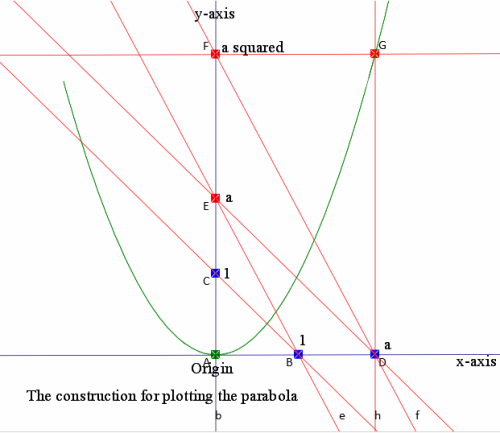Halving the triangle, any triangle, led to the equation XY = 2 as the condition on the points on two sides of the triangle, distant X and Y from the vertex.
The envelope of this set of lines turned out to be a hyperbola.
But XY = 2 defines a hyperbola – what is the connection ?
I took xy = 1 for the condition, on a standard xy grid, and wrote it as representing a function x —-> y, namely y = 1/x
The two points of interest are then (x,0) on the x-axis and (0,1/x) on the y-axis.
We need the equation of the line joining these two points, so first of all we have to see that our x, above, is telling us which line we are talking about, and so it is a parameter for the line.
We had better give it a different name, say p.
Now we can find the equation of the line in x,y form, using (p,0) and (0,1/p) for the two points:
(y – 0)/(1/p – 0) = (x – p)/(0 – p)
which is easier to read as yp = -x/p + 1, and easier to process as yp2 = -x + p
Now comes the fun bit !
To find the envelope of a set of straight lines we have to find the points of intersection of adjacent lines (really? adjacent?). To do this we have to find the partial derivative (derivative treating almost everything as constant) of the line equation with respect to the parameter p. A later post will reveal all about this mystifying procedure).
So do it and get 2yp = 1
And then eliminate p from the two equations, the line one and the derived one:
From the derived equation we get p = 1/(2y), so substituting in the line equation gives 1 = 2xy
This is the equation of the envelope, and written in functional form it is
y = 1/(2x), or (1/2)(1/x)
Yes ! Another rectangular hyperbola, with the same asymptotes.
(write it as xy = 1/2 if you like)
Now I thought “What will this process do with y = x2 ?”
So off I go, and to cut a long story short I found the following:
For y = x2 the envelope was y = (-1/4)x2, also a multiple of the original, with factor -1/4


Some surprise at this point, so I did it for 1/x2 and for x3
Similar results: Same function, with different factors.
Try it yourself ! ! ! ! ! ! !
This was too much ! No stopping ! Must find the general case ! (y = xk)
Skipping the now familiar details (left to the reader, in time honoured fashion) I found the following:
Original equation: y = xk
Equation of envelope: y = xk multiplied by -(k-1)k-1/kk
which I did think was quite neat.
—————————————————————
The next post will be the last follow-up to the triangle halving.
—————————————————————
Constructions made with GEOSTRUCT, an online browser application:
To get geostruct from the net click
http://www.mathcomesalive.com/geostruct/geostructforbrowser1.html
and to download the .doc instructions file
http://www.mathcomesalive.com/geostruct/geostruct basics.doc

 Constructions done with my web based program. Try it yourself: GEOSTRUCT
Constructions done with my web based program. Try it yourself: GEOSTRUCT














